Sustainability and Integrated Reporting
VerifiedAdded on 2023/06/10
|11
|2198
|118
AI Summary
The report evaluates the sustainability reports of BHP Billiton and Rio Tinto, analyses the similarities and differences between the reports, and evaluates the quality of information, consistency with GRI standards, and information needs of stakeholders. It follows the guidelines laid down in Global Reporting Initiative (GRI).
Contribute Materials
Your contribution can guide someone’s learning journey. Share your
documents today.

Running head: SUSTAINABILITY AND INTEGRATED REPORTING
Sustainability and Integrated Reporting
Name of the Student:
Name of the University:
Author’s Note:
Course ID:
Sustainability and Integrated Reporting
Name of the Student:
Name of the University:
Author’s Note:
Course ID:
Secure Best Marks with AI Grader
Need help grading? Try our AI Grader for instant feedback on your assignments.
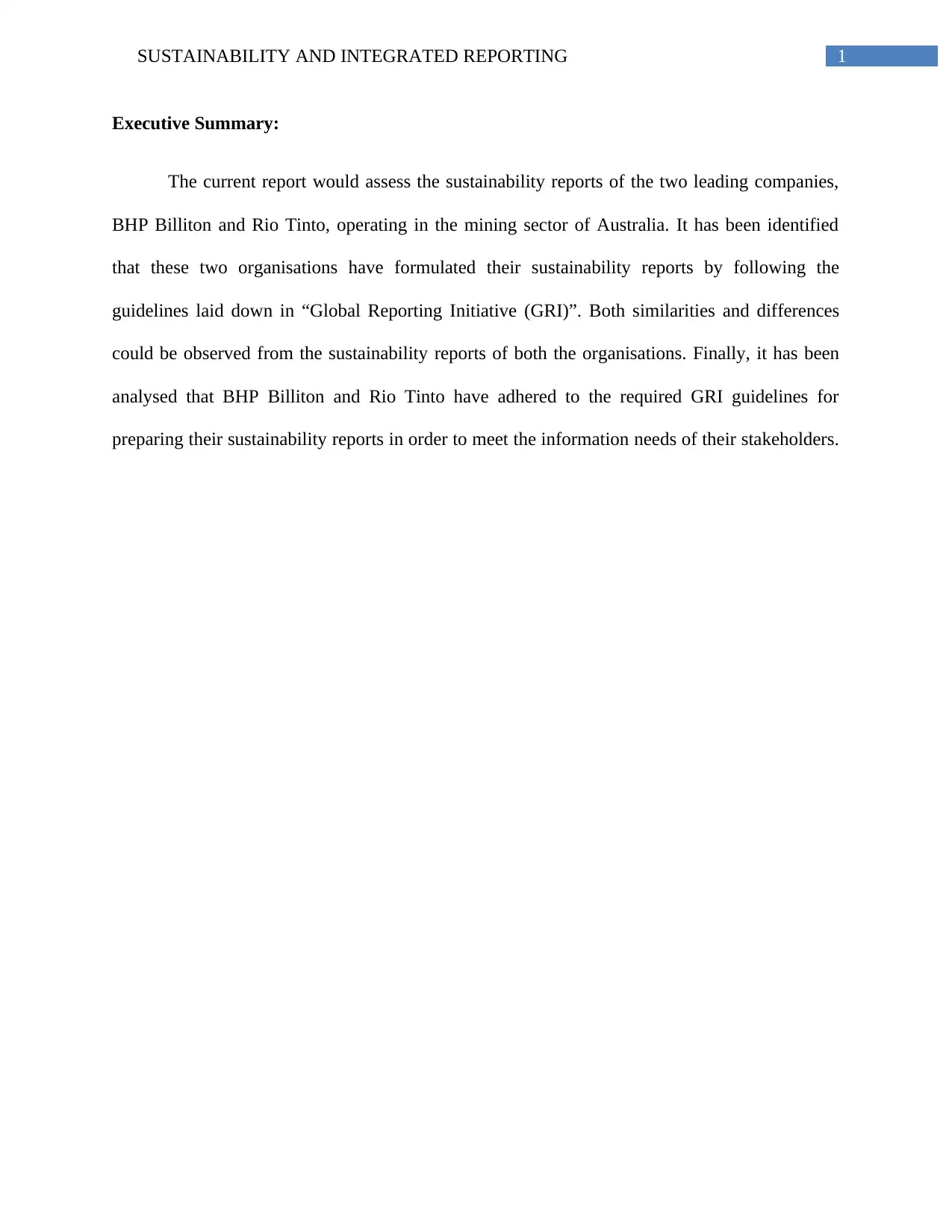
1SUSTAINABILITY AND INTEGRATED REPORTING
Executive Summary:
The current report would assess the sustainability reports of the two leading companies,
BHP Billiton and Rio Tinto, operating in the mining sector of Australia. It has been identified
that these two organisations have formulated their sustainability reports by following the
guidelines laid down in “Global Reporting Initiative (GRI)”. Both similarities and differences
could be observed from the sustainability reports of both the organisations. Finally, it has been
analysed that BHP Billiton and Rio Tinto have adhered to the required GRI guidelines for
preparing their sustainability reports in order to meet the information needs of their stakeholders.
Executive Summary:
The current report would assess the sustainability reports of the two leading companies,
BHP Billiton and Rio Tinto, operating in the mining sector of Australia. It has been identified
that these two organisations have formulated their sustainability reports by following the
guidelines laid down in “Global Reporting Initiative (GRI)”. Both similarities and differences
could be observed from the sustainability reports of both the organisations. Finally, it has been
analysed that BHP Billiton and Rio Tinto have adhered to the required GRI guidelines for
preparing their sustainability reports in order to meet the information needs of their stakeholders.
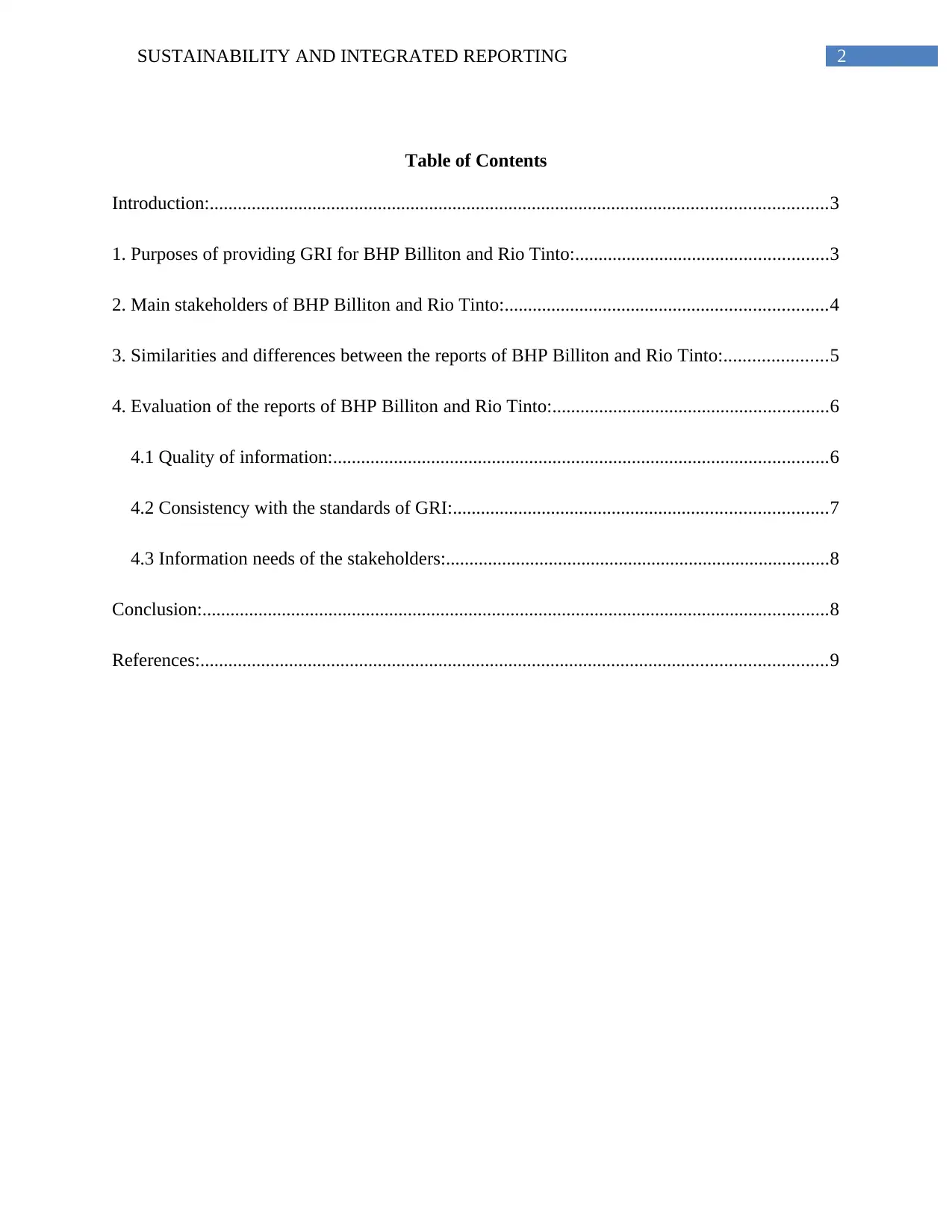
2SUSTAINABILITY AND INTEGRATED REPORTING
Table of Contents
Introduction:....................................................................................................................................3
1. Purposes of providing GRI for BHP Billiton and Rio Tinto:......................................................3
2. Main stakeholders of BHP Billiton and Rio Tinto:.....................................................................4
3. Similarities and differences between the reports of BHP Billiton and Rio Tinto:......................5
4. Evaluation of the reports of BHP Billiton and Rio Tinto:...........................................................6
4.1 Quality of information:..........................................................................................................6
4.2 Consistency with the standards of GRI:................................................................................7
4.3 Information needs of the stakeholders:..................................................................................8
Conclusion:......................................................................................................................................8
References:......................................................................................................................................9
Table of Contents
Introduction:....................................................................................................................................3
1. Purposes of providing GRI for BHP Billiton and Rio Tinto:......................................................3
2. Main stakeholders of BHP Billiton and Rio Tinto:.....................................................................4
3. Similarities and differences between the reports of BHP Billiton and Rio Tinto:......................5
4. Evaluation of the reports of BHP Billiton and Rio Tinto:...........................................................6
4.1 Quality of information:..........................................................................................................6
4.2 Consistency with the standards of GRI:................................................................................7
4.3 Information needs of the stakeholders:..................................................................................8
Conclusion:......................................................................................................................................8
References:......................................................................................................................................9
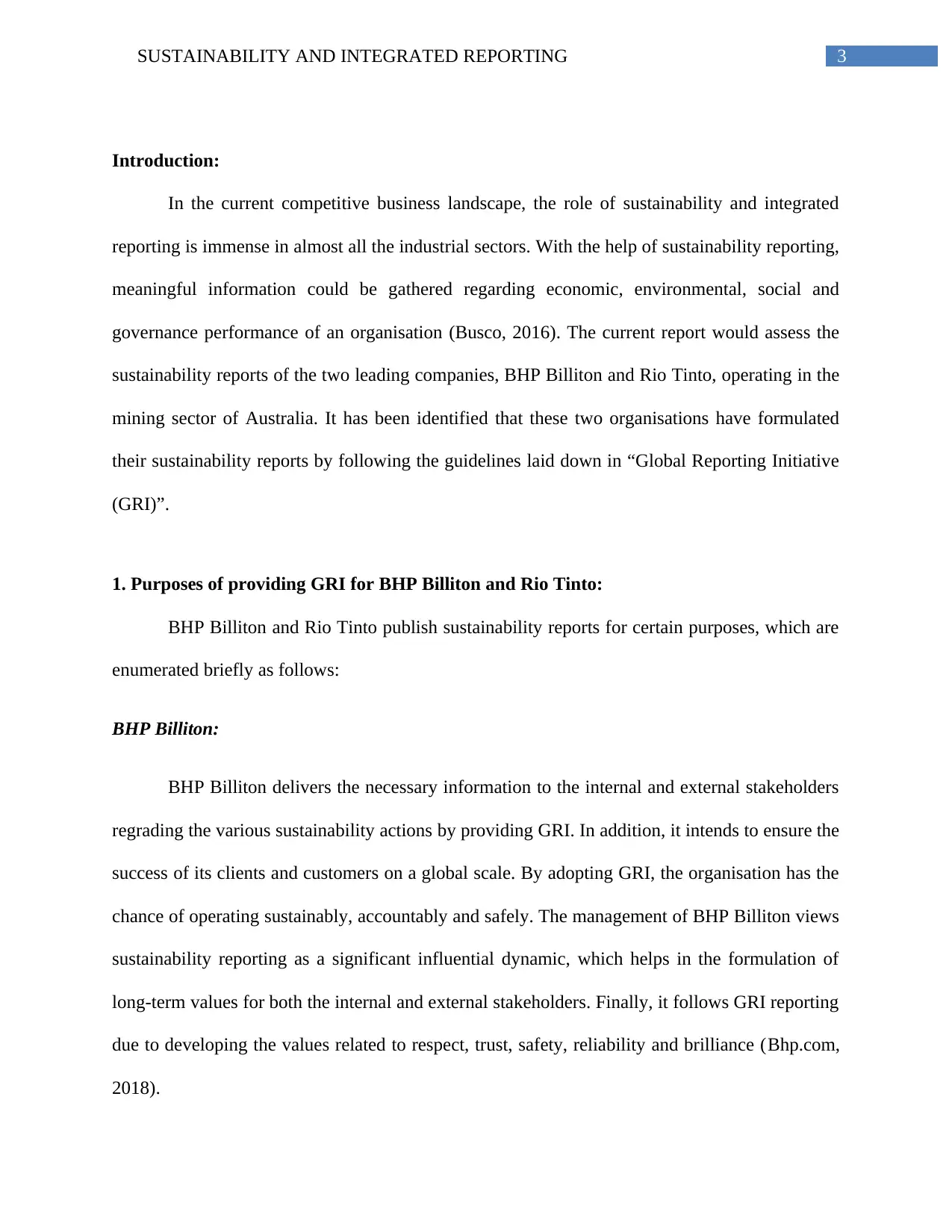
3SUSTAINABILITY AND INTEGRATED REPORTING
Introduction:
In the current competitive business landscape, the role of sustainability and integrated
reporting is immense in almost all the industrial sectors. With the help of sustainability reporting,
meaningful information could be gathered regarding economic, environmental, social and
governance performance of an organisation (Busco, 2016). The current report would assess the
sustainability reports of the two leading companies, BHP Billiton and Rio Tinto, operating in the
mining sector of Australia. It has been identified that these two organisations have formulated
their sustainability reports by following the guidelines laid down in “Global Reporting Initiative
(GRI)”.
1. Purposes of providing GRI for BHP Billiton and Rio Tinto:
BHP Billiton and Rio Tinto publish sustainability reports for certain purposes, which are
enumerated briefly as follows:
BHP Billiton:
BHP Billiton delivers the necessary information to the internal and external stakeholders
regrading the various sustainability actions by providing GRI. In addition, it intends to ensure the
success of its clients and customers on a global scale. By adopting GRI, the organisation has the
chance of operating sustainably, accountably and safely. The management of BHP Billiton views
sustainability reporting as a significant influential dynamic, which helps in the formulation of
long-term values for both the internal and external stakeholders. Finally, it follows GRI reporting
due to developing the values related to respect, trust, safety, reliability and brilliance (Bhp.com,
2018).
Introduction:
In the current competitive business landscape, the role of sustainability and integrated
reporting is immense in almost all the industrial sectors. With the help of sustainability reporting,
meaningful information could be gathered regarding economic, environmental, social and
governance performance of an organisation (Busco, 2016). The current report would assess the
sustainability reports of the two leading companies, BHP Billiton and Rio Tinto, operating in the
mining sector of Australia. It has been identified that these two organisations have formulated
their sustainability reports by following the guidelines laid down in “Global Reporting Initiative
(GRI)”.
1. Purposes of providing GRI for BHP Billiton and Rio Tinto:
BHP Billiton and Rio Tinto publish sustainability reports for certain purposes, which are
enumerated briefly as follows:
BHP Billiton:
BHP Billiton delivers the necessary information to the internal and external stakeholders
regrading the various sustainability actions by providing GRI. In addition, it intends to ensure the
success of its clients and customers on a global scale. By adopting GRI, the organisation has the
chance of operating sustainably, accountably and safely. The management of BHP Billiton views
sustainability reporting as a significant influential dynamic, which helps in the formulation of
long-term values for both the internal and external stakeholders. Finally, it follows GRI reporting
due to developing the values related to respect, trust, safety, reliability and brilliance (Bhp.com,
2018).
Secure Best Marks with AI Grader
Need help grading? Try our AI Grader for instant feedback on your assignments.
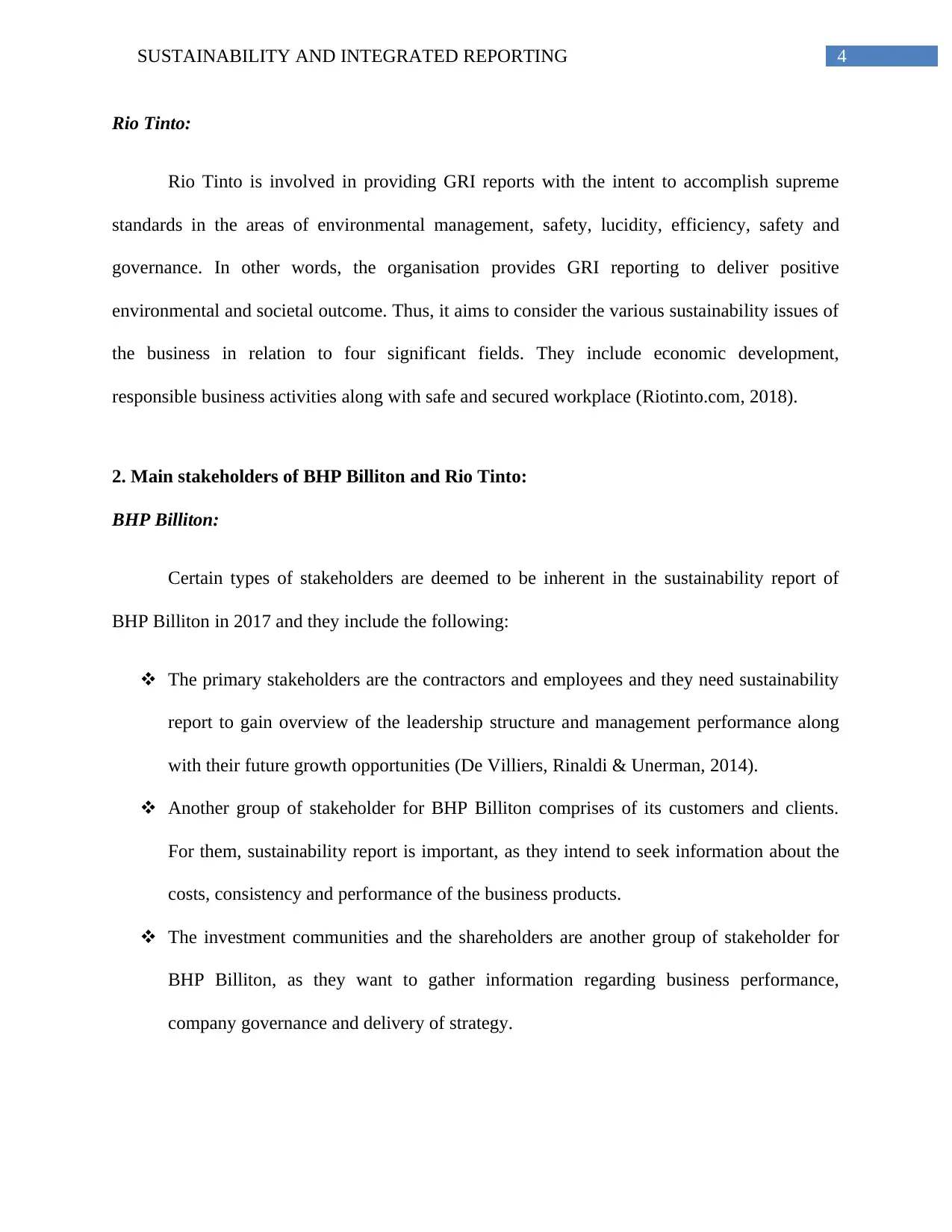
4SUSTAINABILITY AND INTEGRATED REPORTING
Rio Tinto:
Rio Tinto is involved in providing GRI reports with the intent to accomplish supreme
standards in the areas of environmental management, safety, lucidity, efficiency, safety and
governance. In other words, the organisation provides GRI reporting to deliver positive
environmental and societal outcome. Thus, it aims to consider the various sustainability issues of
the business in relation to four significant fields. They include economic development,
responsible business activities along with safe and secured workplace (Riotinto.com, 2018).
2. Main stakeholders of BHP Billiton and Rio Tinto:
BHP Billiton:
Certain types of stakeholders are deemed to be inherent in the sustainability report of
BHP Billiton in 2017 and they include the following:
The primary stakeholders are the contractors and employees and they need sustainability
report to gain overview of the leadership structure and management performance along
with their future growth opportunities (De Villiers, Rinaldi & Unerman, 2014).
Another group of stakeholder for BHP Billiton comprises of its customers and clients.
For them, sustainability report is important, as they intend to seek information about the
costs, consistency and performance of the business products.
The investment communities and the shareholders are another group of stakeholder for
BHP Billiton, as they want to gather information regarding business performance,
company governance and delivery of strategy.
Rio Tinto:
Rio Tinto is involved in providing GRI reports with the intent to accomplish supreme
standards in the areas of environmental management, safety, lucidity, efficiency, safety and
governance. In other words, the organisation provides GRI reporting to deliver positive
environmental and societal outcome. Thus, it aims to consider the various sustainability issues of
the business in relation to four significant fields. They include economic development,
responsible business activities along with safe and secured workplace (Riotinto.com, 2018).
2. Main stakeholders of BHP Billiton and Rio Tinto:
BHP Billiton:
Certain types of stakeholders are deemed to be inherent in the sustainability report of
BHP Billiton in 2017 and they include the following:
The primary stakeholders are the contractors and employees and they need sustainability
report to gain overview of the leadership structure and management performance along
with their future growth opportunities (De Villiers, Rinaldi & Unerman, 2014).
Another group of stakeholder for BHP Billiton comprises of its customers and clients.
For them, sustainability report is important, as they intend to seek information about the
costs, consistency and performance of the business products.
The investment communities and the shareholders are another group of stakeholder for
BHP Billiton, as they want to gather information regarding business performance,
company governance and delivery of strategy.

5SUSTAINABILITY AND INTEGRATED REPORTING
The local individuals and the community are the other stakeholders and they want to
obtain information the employment opportunity, effects of the business operations along
with social as well as economic contributions.
Finally, government is another important stakeholder of BHP Billiton and it has the
responsibility of assuring that the organisation has adhered to the GRI guidelines in terms
of research and development along with addressing the issues of the local communities.
Rio Tinto:
Rio Tinto has certain groups of stakeholders, which are demonstrated briefly as follows:
The first stakeholder group consists of the employees and they want to accumulate
information about health and safety measures along with issues related to training and
sustainability.
Customers are another important group, since they want to know about the product and
service quality for making future purchase decisions (Flower, 2015).
The suppliers and contractors are the other stakeholder group, as their interest is to ensure
open products as well as practice procurement.
The next stakeholder includes the local communities, as they would intend to know about
the effects of business operations on the community.
Shareholders are another type of stakeholder, as they like to gain an overview about the
economic performance of the organisation.
Finally, the regulators and the government are the other stakeholders, which would like to
know about the environmental as well as economic effects of the business operations
(Hughen, Lulseged & Upton, 2014).
The local individuals and the community are the other stakeholders and they want to
obtain information the employment opportunity, effects of the business operations along
with social as well as economic contributions.
Finally, government is another important stakeholder of BHP Billiton and it has the
responsibility of assuring that the organisation has adhered to the GRI guidelines in terms
of research and development along with addressing the issues of the local communities.
Rio Tinto:
Rio Tinto has certain groups of stakeholders, which are demonstrated briefly as follows:
The first stakeholder group consists of the employees and they want to accumulate
information about health and safety measures along with issues related to training and
sustainability.
Customers are another important group, since they want to know about the product and
service quality for making future purchase decisions (Flower, 2015).
The suppliers and contractors are the other stakeholder group, as their interest is to ensure
open products as well as practice procurement.
The next stakeholder includes the local communities, as they would intend to know about
the effects of business operations on the community.
Shareholders are another type of stakeholder, as they like to gain an overview about the
economic performance of the organisation.
Finally, the regulators and the government are the other stakeholders, which would like to
know about the environmental as well as economic effects of the business operations
(Hughen, Lulseged & Upton, 2014).
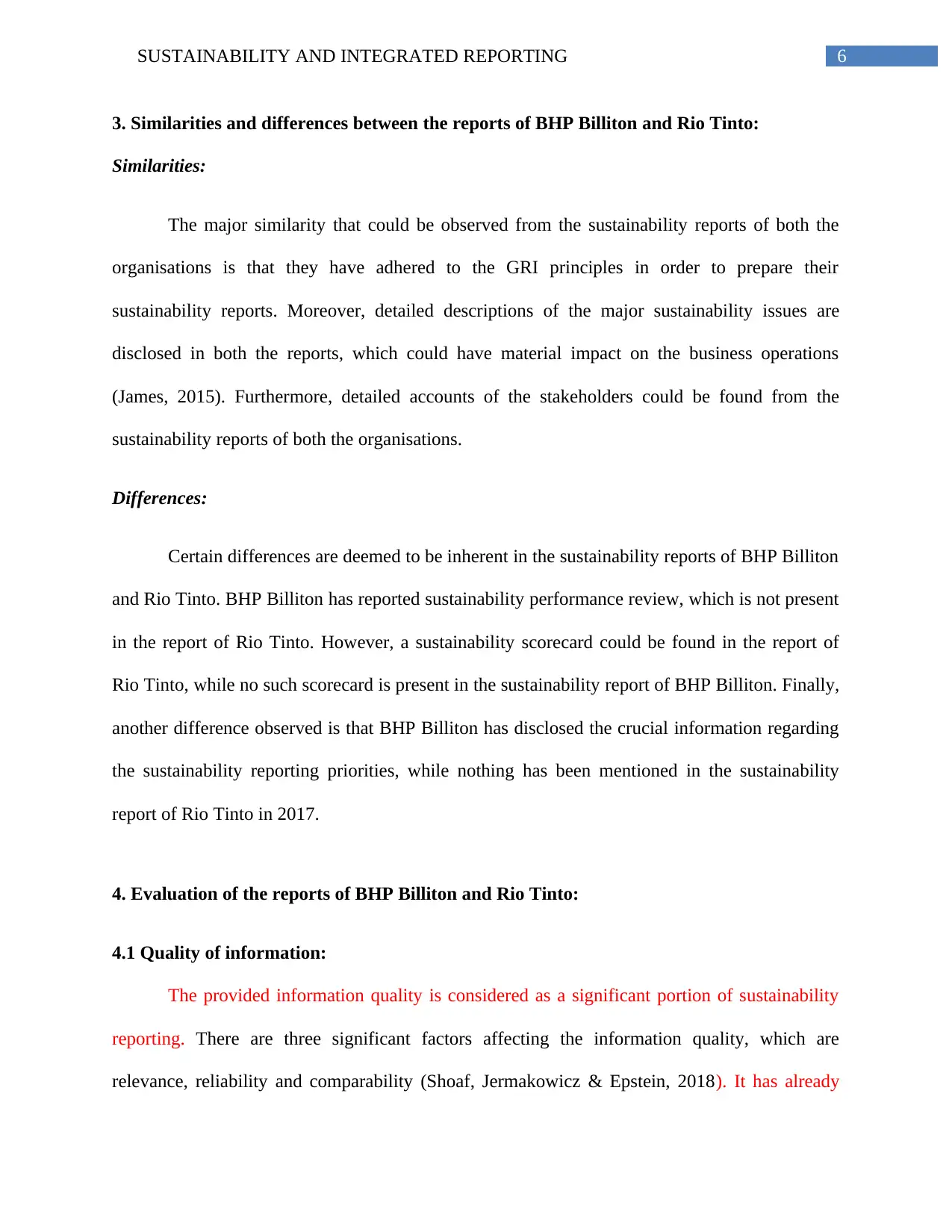
6SUSTAINABILITY AND INTEGRATED REPORTING
3. Similarities and differences between the reports of BHP Billiton and Rio Tinto:
Similarities:
The major similarity that could be observed from the sustainability reports of both the
organisations is that they have adhered to the GRI principles in order to prepare their
sustainability reports. Moreover, detailed descriptions of the major sustainability issues are
disclosed in both the reports, which could have material impact on the business operations
(James, 2015). Furthermore, detailed accounts of the stakeholders could be found from the
sustainability reports of both the organisations.
Differences:
Certain differences are deemed to be inherent in the sustainability reports of BHP Billiton
and Rio Tinto. BHP Billiton has reported sustainability performance review, which is not present
in the report of Rio Tinto. However, a sustainability scorecard could be found in the report of
Rio Tinto, while no such scorecard is present in the sustainability report of BHP Billiton. Finally,
another difference observed is that BHP Billiton has disclosed the crucial information regarding
the sustainability reporting priorities, while nothing has been mentioned in the sustainability
report of Rio Tinto in 2017.
4. Evaluation of the reports of BHP Billiton and Rio Tinto:
4.1 Quality of information:
The provided information quality is considered as a significant portion of sustainability
reporting. There are three significant factors affecting the information quality, which are
relevance, reliability and comparability (Shoaf, Jermakowicz & Epstein, 2018). It has already
3. Similarities and differences between the reports of BHP Billiton and Rio Tinto:
Similarities:
The major similarity that could be observed from the sustainability reports of both the
organisations is that they have adhered to the GRI principles in order to prepare their
sustainability reports. Moreover, detailed descriptions of the major sustainability issues are
disclosed in both the reports, which could have material impact on the business operations
(James, 2015). Furthermore, detailed accounts of the stakeholders could be found from the
sustainability reports of both the organisations.
Differences:
Certain differences are deemed to be inherent in the sustainability reports of BHP Billiton
and Rio Tinto. BHP Billiton has reported sustainability performance review, which is not present
in the report of Rio Tinto. However, a sustainability scorecard could be found in the report of
Rio Tinto, while no such scorecard is present in the sustainability report of BHP Billiton. Finally,
another difference observed is that BHP Billiton has disclosed the crucial information regarding
the sustainability reporting priorities, while nothing has been mentioned in the sustainability
report of Rio Tinto in 2017.
4. Evaluation of the reports of BHP Billiton and Rio Tinto:
4.1 Quality of information:
The provided information quality is considered as a significant portion of sustainability
reporting. There are three significant factors affecting the information quality, which are
relevance, reliability and comparability (Shoaf, Jermakowicz & Epstein, 2018). It has already
Paraphrase This Document
Need a fresh take? Get an instant paraphrase of this document with our AI Paraphraser
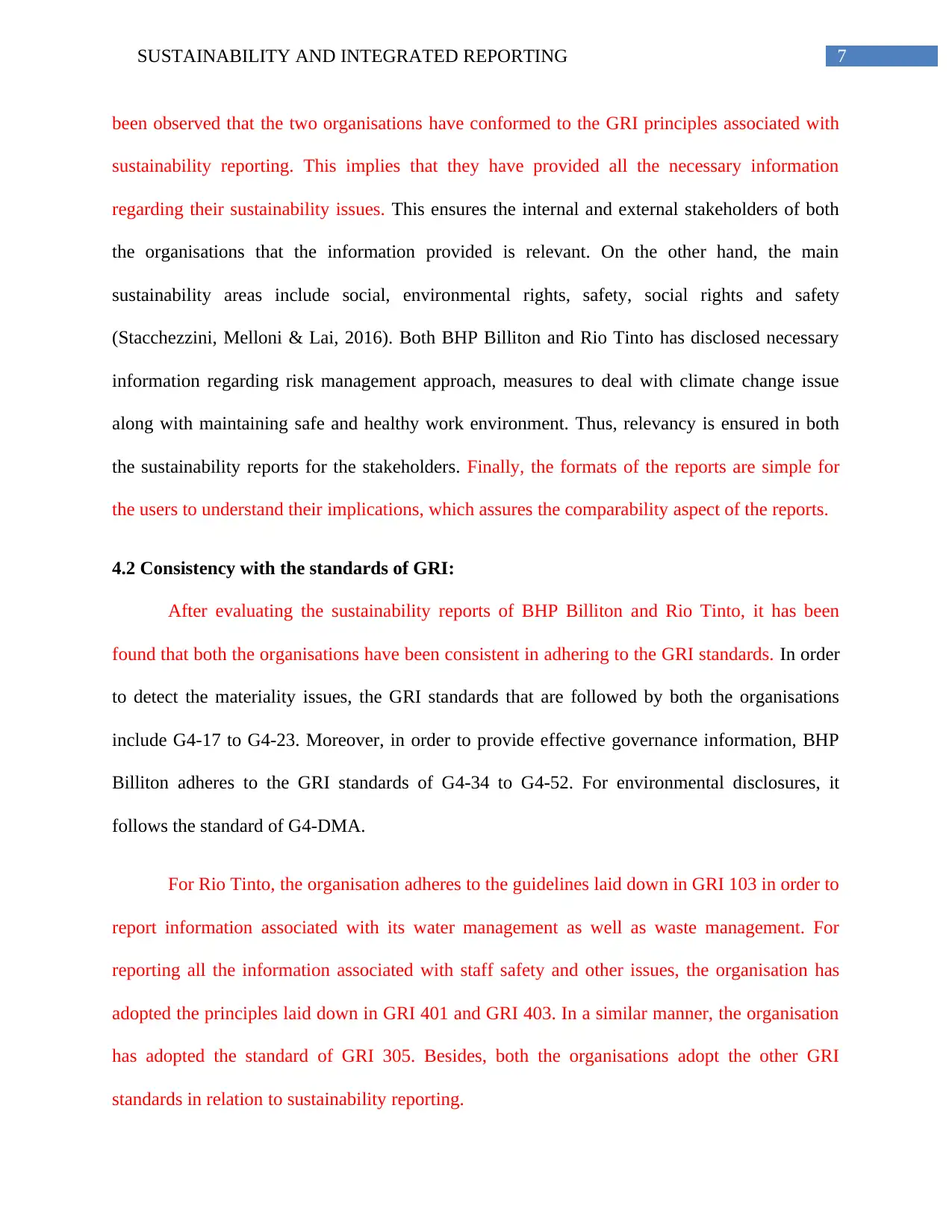
7SUSTAINABILITY AND INTEGRATED REPORTING
been observed that the two organisations have conformed to the GRI principles associated with
sustainability reporting. This implies that they have provided all the necessary information
regarding their sustainability issues. This ensures the internal and external stakeholders of both
the organisations that the information provided is relevant. On the other hand, the main
sustainability areas include social, environmental rights, safety, social rights and safety
(Stacchezzini, Melloni & Lai, 2016). Both BHP Billiton and Rio Tinto has disclosed necessary
information regarding risk management approach, measures to deal with climate change issue
along with maintaining safe and healthy work environment. Thus, relevancy is ensured in both
the sustainability reports for the stakeholders. Finally, the formats of the reports are simple for
the users to understand their implications, which assures the comparability aspect of the reports.
4.2 Consistency with the standards of GRI:
After evaluating the sustainability reports of BHP Billiton and Rio Tinto, it has been
found that both the organisations have been consistent in adhering to the GRI standards. In order
to detect the materiality issues, the GRI standards that are followed by both the organisations
include G4-17 to G4-23. Moreover, in order to provide effective governance information, BHP
Billiton adheres to the GRI standards of G4-34 to G4-52. For environmental disclosures, it
follows the standard of G4-DMA.
For Rio Tinto, the organisation adheres to the guidelines laid down in GRI 103 in order to
report information associated with its water management as well as waste management. For
reporting all the information associated with staff safety and other issues, the organisation has
adopted the principles laid down in GRI 401 and GRI 403. In a similar manner, the organisation
has adopted the standard of GRI 305. Besides, both the organisations adopt the other GRI
standards in relation to sustainability reporting.
been observed that the two organisations have conformed to the GRI principles associated with
sustainability reporting. This implies that they have provided all the necessary information
regarding their sustainability issues. This ensures the internal and external stakeholders of both
the organisations that the information provided is relevant. On the other hand, the main
sustainability areas include social, environmental rights, safety, social rights and safety
(Stacchezzini, Melloni & Lai, 2016). Both BHP Billiton and Rio Tinto has disclosed necessary
information regarding risk management approach, measures to deal with climate change issue
along with maintaining safe and healthy work environment. Thus, relevancy is ensured in both
the sustainability reports for the stakeholders. Finally, the formats of the reports are simple for
the users to understand their implications, which assures the comparability aspect of the reports.
4.2 Consistency with the standards of GRI:
After evaluating the sustainability reports of BHP Billiton and Rio Tinto, it has been
found that both the organisations have been consistent in adhering to the GRI standards. In order
to detect the materiality issues, the GRI standards that are followed by both the organisations
include G4-17 to G4-23. Moreover, in order to provide effective governance information, BHP
Billiton adheres to the GRI standards of G4-34 to G4-52. For environmental disclosures, it
follows the standard of G4-DMA.
For Rio Tinto, the organisation adheres to the guidelines laid down in GRI 103 in order to
report information associated with its water management as well as waste management. For
reporting all the information associated with staff safety and other issues, the organisation has
adopted the principles laid down in GRI 401 and GRI 403. In a similar manner, the organisation
has adopted the standard of GRI 305. Besides, both the organisations adopt the other GRI
standards in relation to sustainability reporting.
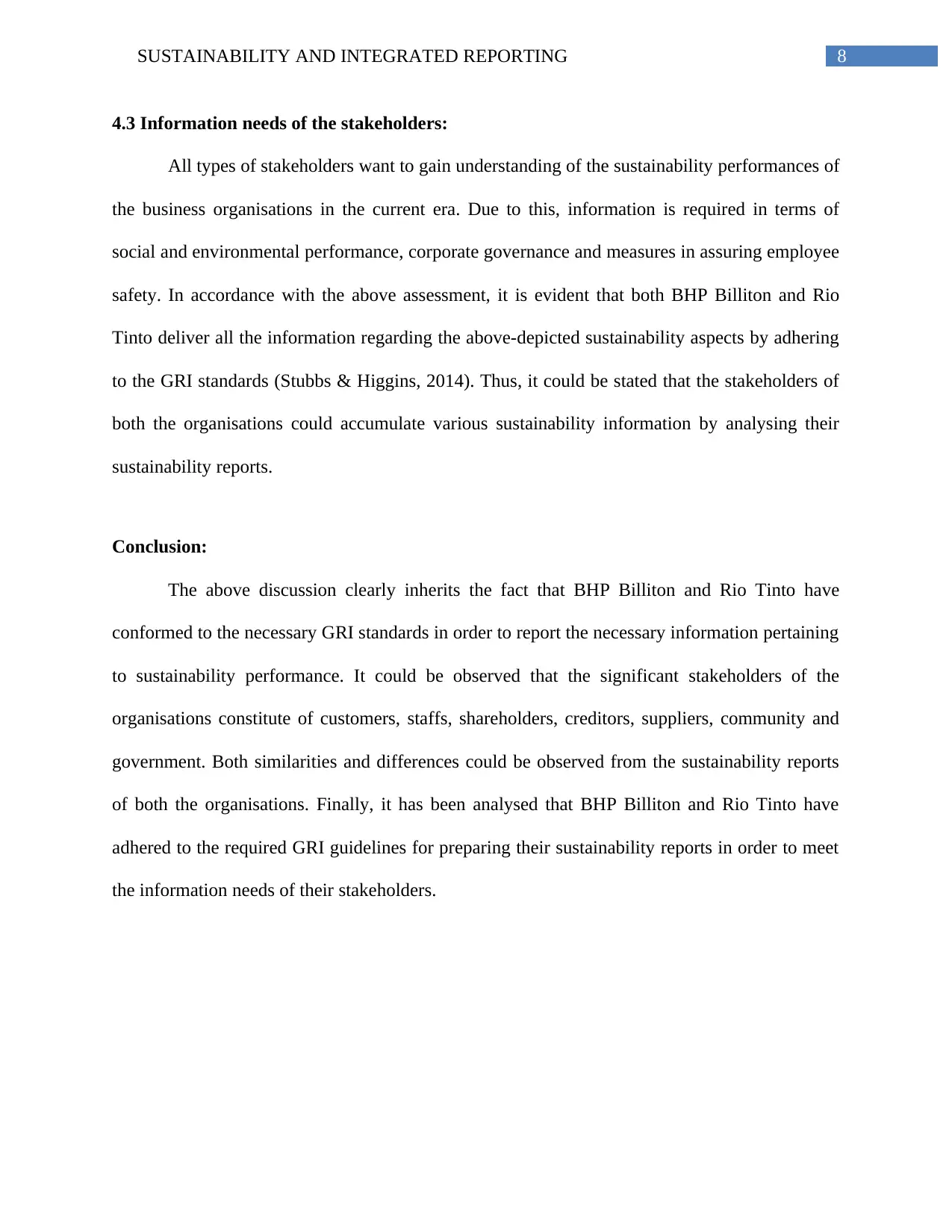
8SUSTAINABILITY AND INTEGRATED REPORTING
4.3 Information needs of the stakeholders:
All types of stakeholders want to gain understanding of the sustainability performances of
the business organisations in the current era. Due to this, information is required in terms of
social and environmental performance, corporate governance and measures in assuring employee
safety. In accordance with the above assessment, it is evident that both BHP Billiton and Rio
Tinto deliver all the information regarding the above-depicted sustainability aspects by adhering
to the GRI standards (Stubbs & Higgins, 2014). Thus, it could be stated that the stakeholders of
both the organisations could accumulate various sustainability information by analysing their
sustainability reports.
Conclusion:
The above discussion clearly inherits the fact that BHP Billiton and Rio Tinto have
conformed to the necessary GRI standards in order to report the necessary information pertaining
to sustainability performance. It could be observed that the significant stakeholders of the
organisations constitute of customers, staffs, shareholders, creditors, suppliers, community and
government. Both similarities and differences could be observed from the sustainability reports
of both the organisations. Finally, it has been analysed that BHP Billiton and Rio Tinto have
adhered to the required GRI guidelines for preparing their sustainability reports in order to meet
the information needs of their stakeholders.
4.3 Information needs of the stakeholders:
All types of stakeholders want to gain understanding of the sustainability performances of
the business organisations in the current era. Due to this, information is required in terms of
social and environmental performance, corporate governance and measures in assuring employee
safety. In accordance with the above assessment, it is evident that both BHP Billiton and Rio
Tinto deliver all the information regarding the above-depicted sustainability aspects by adhering
to the GRI standards (Stubbs & Higgins, 2014). Thus, it could be stated that the stakeholders of
both the organisations could accumulate various sustainability information by analysing their
sustainability reports.
Conclusion:
The above discussion clearly inherits the fact that BHP Billiton and Rio Tinto have
conformed to the necessary GRI standards in order to report the necessary information pertaining
to sustainability performance. It could be observed that the significant stakeholders of the
organisations constitute of customers, staffs, shareholders, creditors, suppliers, community and
government. Both similarities and differences could be observed from the sustainability reports
of both the organisations. Finally, it has been analysed that BHP Billiton and Rio Tinto have
adhered to the required GRI guidelines for preparing their sustainability reports in order to meet
the information needs of their stakeholders.
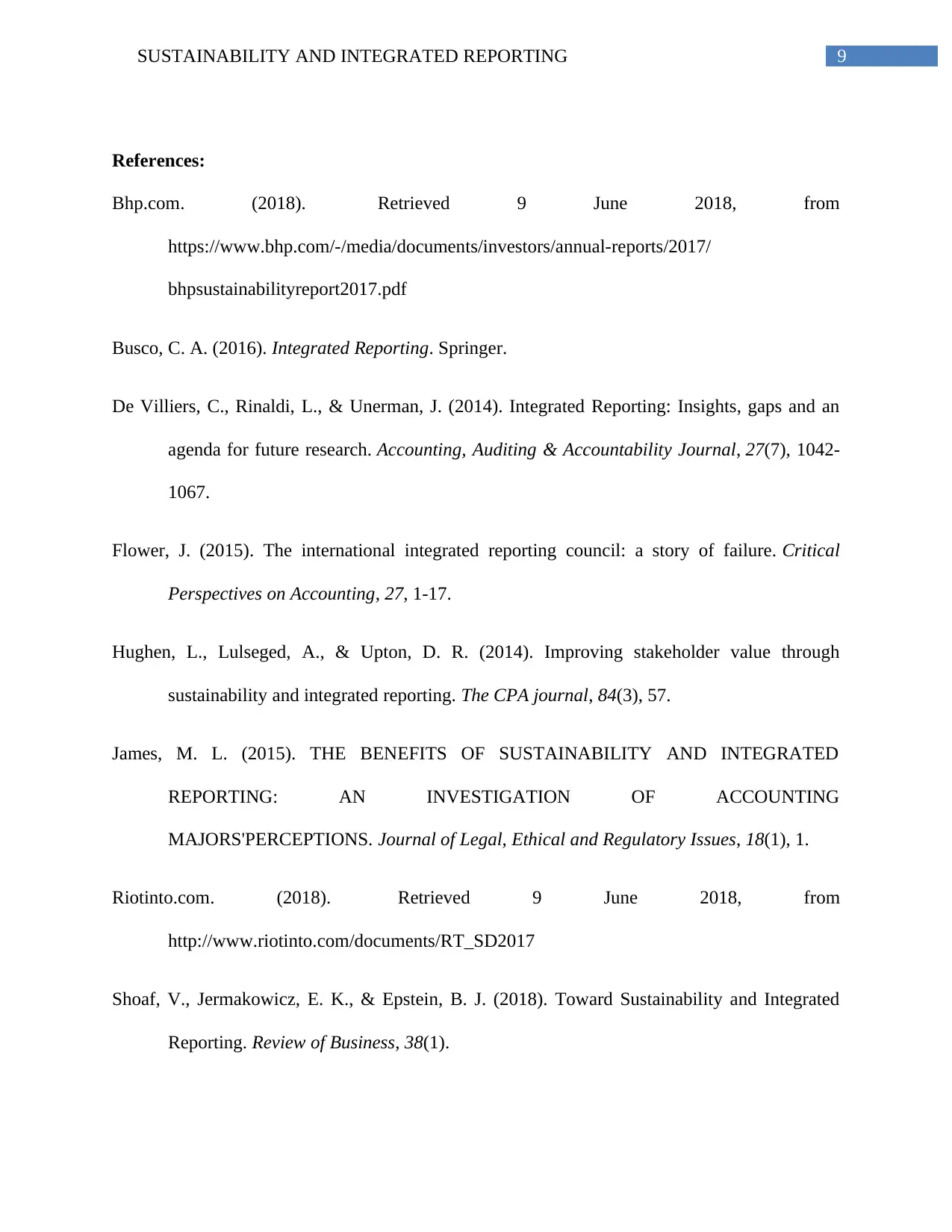
9SUSTAINABILITY AND INTEGRATED REPORTING
References:
Bhp.com. (2018). Retrieved 9 June 2018, from
https://www.bhp.com/-/media/documents/investors/annual-reports/2017/
bhpsustainabilityreport2017.pdf
Busco, C. A. (2016). Integrated Reporting. Springer.
De Villiers, C., Rinaldi, L., & Unerman, J. (2014). Integrated Reporting: Insights, gaps and an
agenda for future research. Accounting, Auditing & Accountability Journal, 27(7), 1042-
1067.
Flower, J. (2015). The international integrated reporting council: a story of failure. Critical
Perspectives on Accounting, 27, 1-17.
Hughen, L., Lulseged, A., & Upton, D. R. (2014). Improving stakeholder value through
sustainability and integrated reporting. The CPA journal, 84(3), 57.
James, M. L. (2015). THE BENEFITS OF SUSTAINABILITY AND INTEGRATED
REPORTING: AN INVESTIGATION OF ACCOUNTING
MAJORS'PERCEPTIONS. Journal of Legal, Ethical and Regulatory Issues, 18(1), 1.
Riotinto.com. (2018). Retrieved 9 June 2018, from
http://www.riotinto.com/documents/RT_SD2017
Shoaf, V., Jermakowicz, E. K., & Epstein, B. J. (2018). Toward Sustainability and Integrated
Reporting. Review of Business, 38(1).
References:
Bhp.com. (2018). Retrieved 9 June 2018, from
https://www.bhp.com/-/media/documents/investors/annual-reports/2017/
bhpsustainabilityreport2017.pdf
Busco, C. A. (2016). Integrated Reporting. Springer.
De Villiers, C., Rinaldi, L., & Unerman, J. (2014). Integrated Reporting: Insights, gaps and an
agenda for future research. Accounting, Auditing & Accountability Journal, 27(7), 1042-
1067.
Flower, J. (2015). The international integrated reporting council: a story of failure. Critical
Perspectives on Accounting, 27, 1-17.
Hughen, L., Lulseged, A., & Upton, D. R. (2014). Improving stakeholder value through
sustainability and integrated reporting. The CPA journal, 84(3), 57.
James, M. L. (2015). THE BENEFITS OF SUSTAINABILITY AND INTEGRATED
REPORTING: AN INVESTIGATION OF ACCOUNTING
MAJORS'PERCEPTIONS. Journal of Legal, Ethical and Regulatory Issues, 18(1), 1.
Riotinto.com. (2018). Retrieved 9 June 2018, from
http://www.riotinto.com/documents/RT_SD2017
Shoaf, V., Jermakowicz, E. K., & Epstein, B. J. (2018). Toward Sustainability and Integrated
Reporting. Review of Business, 38(1).
Secure Best Marks with AI Grader
Need help grading? Try our AI Grader for instant feedback on your assignments.
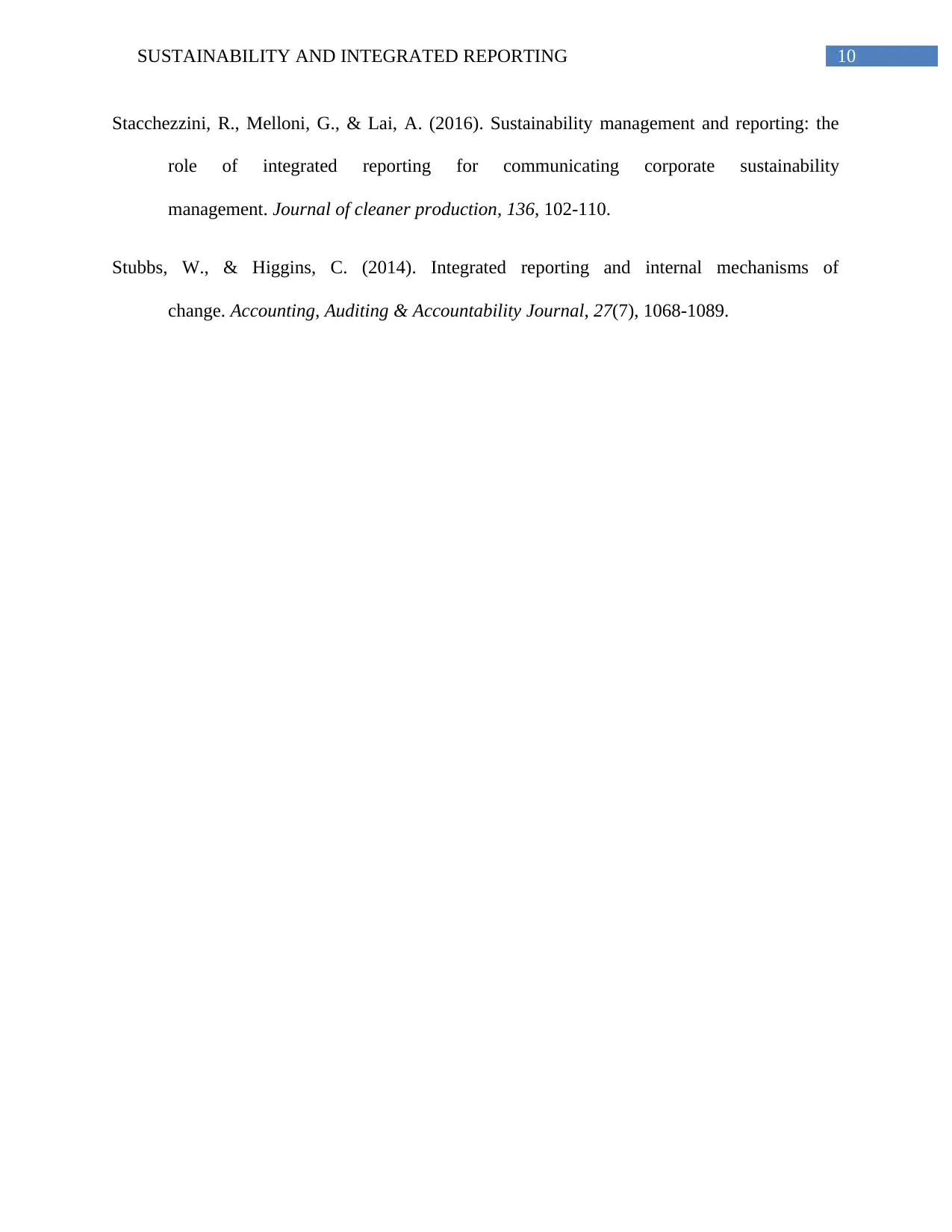
10SUSTAINABILITY AND INTEGRATED REPORTING
Stacchezzini, R., Melloni, G., & Lai, A. (2016). Sustainability management and reporting: the
role of integrated reporting for communicating corporate sustainability
management. Journal of cleaner production, 136, 102-110.
Stubbs, W., & Higgins, C. (2014). Integrated reporting and internal mechanisms of
change. Accounting, Auditing & Accountability Journal, 27(7), 1068-1089.
Stacchezzini, R., Melloni, G., & Lai, A. (2016). Sustainability management and reporting: the
role of integrated reporting for communicating corporate sustainability
management. Journal of cleaner production, 136, 102-110.
Stubbs, W., & Higgins, C. (2014). Integrated reporting and internal mechanisms of
change. Accounting, Auditing & Accountability Journal, 27(7), 1068-1089.
1 out of 11
Related Documents
Your All-in-One AI-Powered Toolkit for Academic Success.
+13062052269
info@desklib.com
Available 24*7 on WhatsApp / Email
![[object Object]](/_next/static/media/star-bottom.7253800d.svg)
Unlock your academic potential
© 2024 | Zucol Services PVT LTD | All rights reserved.




